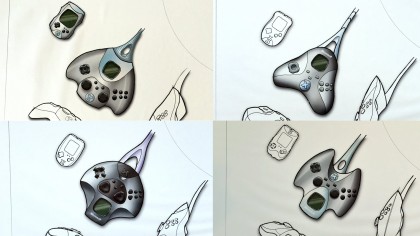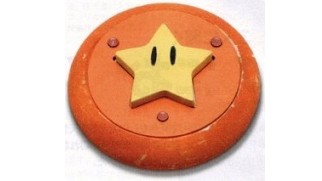5 of the weirdest videogame controllers that almost happened
From stars to boomerangs

Introduction
This week saw Microsoft reveal some of its early Xbox controller designs from before the console's launch in 1999, and they're pretty outlandish.
Usually these early prototypes remain shrouded in secrecy, but these images offer a rare glimpse into the development process of the controllers that we end up holding for hundreds of hours.
In honor of the reveal of the Xbox's aborted controller attempts we decided to revisit four other weird and wonderful controller ideas that for better or for worse never made it to market.

X-Wing-Box
The first thing that strikes you about the look of the Xbox controller prototypes is the small LCD screen at the centre of each of them.
It's not surprising given that the soon-to-be-released Dreamcast also featured a similar screen as part of its controller. It was rarely used for anything interesting, but the thinking was that the screen could be used to display small pieces of information that could be taken off the television screen.
The feature would later be taken to its logical extreme by the Wii U's gamepad, which functions as a fully-fledged touchscreen in its own right.
Outside of the LCD screen it's also great to see that Microsoft experimented with some fantastically bizarre shapes for their debut controller. Personally I'm a fan of the UFO-esque design on the bottom left.

PlayStation Analog Joystick
The dual-joystick gamepad is one of those inventions that's so perfect it's hard to remember a time when it didn't exist. It's like touchscreens before Apple's multi-touch, or bread before sliced bread.
But it took a long time for the industry to reach the dual-joystick standard that exists today. Remember that in arcades the standard was always a single joystick alongside several buttons, and the Nintendo 64 continued this tradition with its single analogue stick.
Sony may have eventually nailed the dual-joystick design with the original DualShock controller, but that wasn't before its admirable attempt with the Analogue Joystick whose two joysticks more closely resembled massive flight sticks than the much smaller thumb sticks that would eventually become the standard.
Unlike the other entries on this list, the Analog Joystick actually made it to market, but we're including it because of how obvious a stepping stone it is between the original PlayStation controller and the eventual DualShock.

Nintendo Star Controller
As it turns out, Nintendo was throwing around some pretty wacky controller prototypes before it eventually settled on the Wii's only-slightly-wacky Wiimote.
The most crazy of these was the Star Controller, a large disk with just four buttons, one of which was a massive Mario star.
The idea appears to have been to have relied almost entirely on motion controls, but as well as being too garish Nintendo's developers also took issue with its ability to control the likes of Mario and Zelda.

The Original Steam Controller
Valve's Steam Controller came about out of a desire to bring the experience of using a mouse and keyboard to the form factor of a traditional game controller, and with a mission statement like that it was never going to play by the rules.
With no joysticks or face buttons to speak of, Valve's original Steam Controller prototype was unorthodox to say the very least.
The two touch-pads that were intended to replace the former did eventually make it into the finished product, but the central touchscreen was replaced by a more traditional trio of menu buttons flanked by traditional face buttons and a single analogue stick.

The Boomerang
Nowadays, with the PS4 outselling the Xbox One so decisively, it's weird to think back to a time when Sony were anything other than the king of the mountain, but at the outset of the PS3's life things weren't looking great for the Japanese electronics giant.
The new console might have been expensive and difficult to develop for, but our fondest memory of Sony's darkest days is the PS3's original controller, which looked like a cross between a boomerang and a sci-fi banana.
Thankfully at the following E3 Sony revealed the 'real' PS3 controller, although we would have to wait a further two years until the PS3 got its de facto controller in the form of the Dualshock 3, which finally brought back the much-needed rumble functionality that was absent from the Sixaxis.

Jon Porter is the ex-Home Technology Writer for TechRadar. He has also previously written for Practical Photoshop, Trusted Reviews, Inside Higher Ed, Al Bawaba, Gizmodo UK, Genetic Literacy Project, Via Satellite, Real Homes and Plant Services Magazine, and you can now find him writing for The Verge.